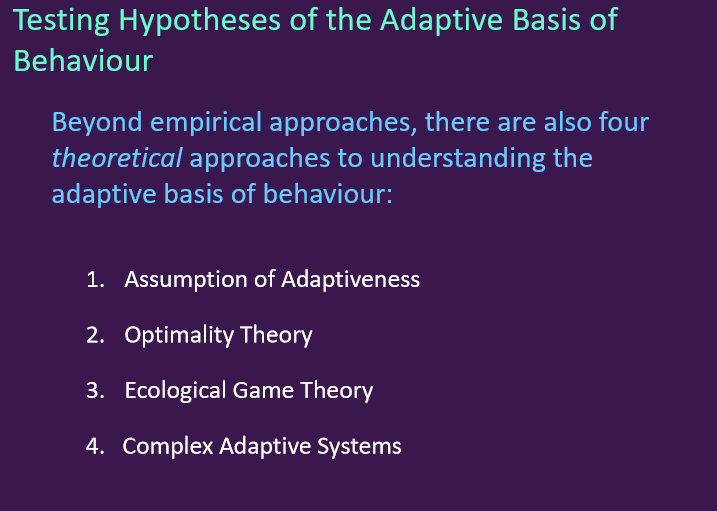5. Learning to Describe and Quantify Animal Behaviour
1/11
There's no tags or description
Looks like no tags are added yet.
Name | Mastery | Learn | Test | Matching | Spaced |
|---|
No study sessions yet.
12 Terms
Scientific Thinking
Science = systemic description and explanation of natural phenomena
Scientific method = formalized way off knowing about the natural world - logical, stepwise approach to scientific research
Scientific Method
Observation - description of phenomenon
Question - formal statement of an unknown that one would like to understand (proximate, ultimate)
Hypothesis - tentative explanation based on assumptions that makes testable prediction
Prediction - statement forecasting what will happen under specific conditions
Test - Designed empirical and theoretical approaches to test predictions
Conclusion
If prediction supports data, we report that we have support for our hypothesis
If prediction is not supported by the data, we reject our hypothesis
If we reject hypothesis, we begin the process again until we find one that is supported
In science we cannot prove hypotheses only reject or support them
Scientific questions in animal behaviour: True or false, research begins with a scientific question based on an observation
True -
Scientific questions in Animal Behaviour - Characteristics of a good research question
Researchable - does it produce testable hypotheses
Arguable - does it produce evidence in favor of one argument over another
Answerable - can it be designed so that an answer is obtained
Defined, measurable, and contrasted against an alternative
Creating Scientific Questions that are testable (4)
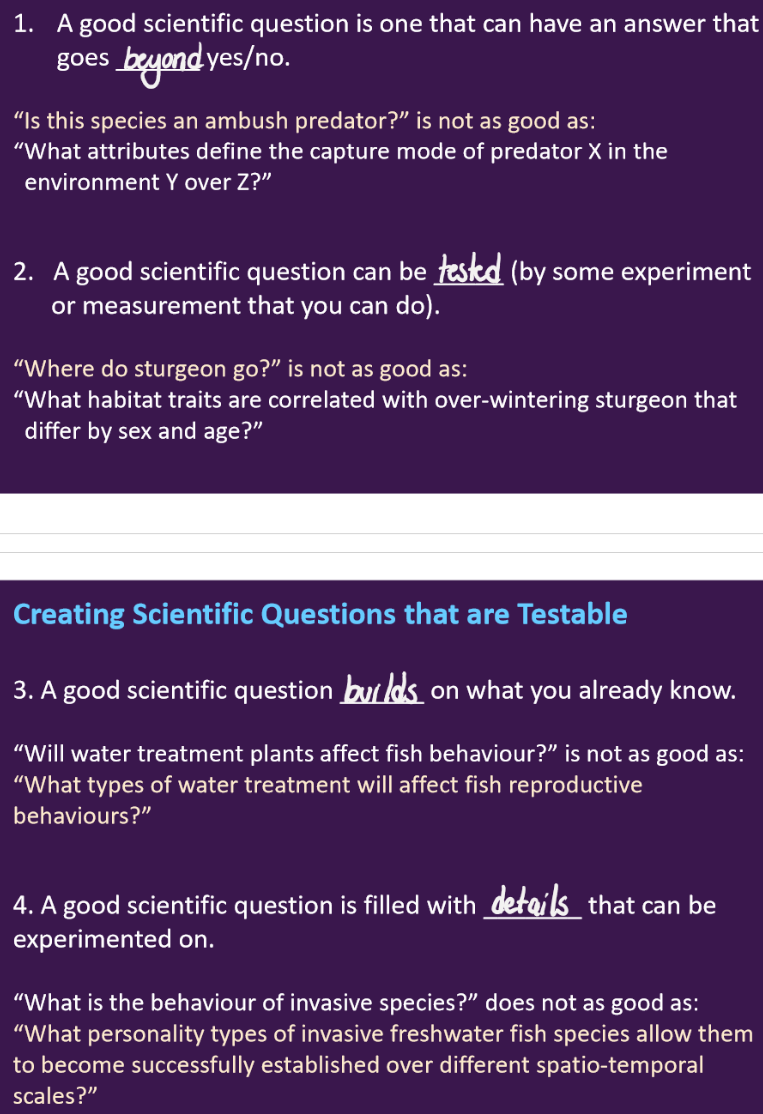
Scientific questions in Animal Behaviour - Are the following scientific questions?
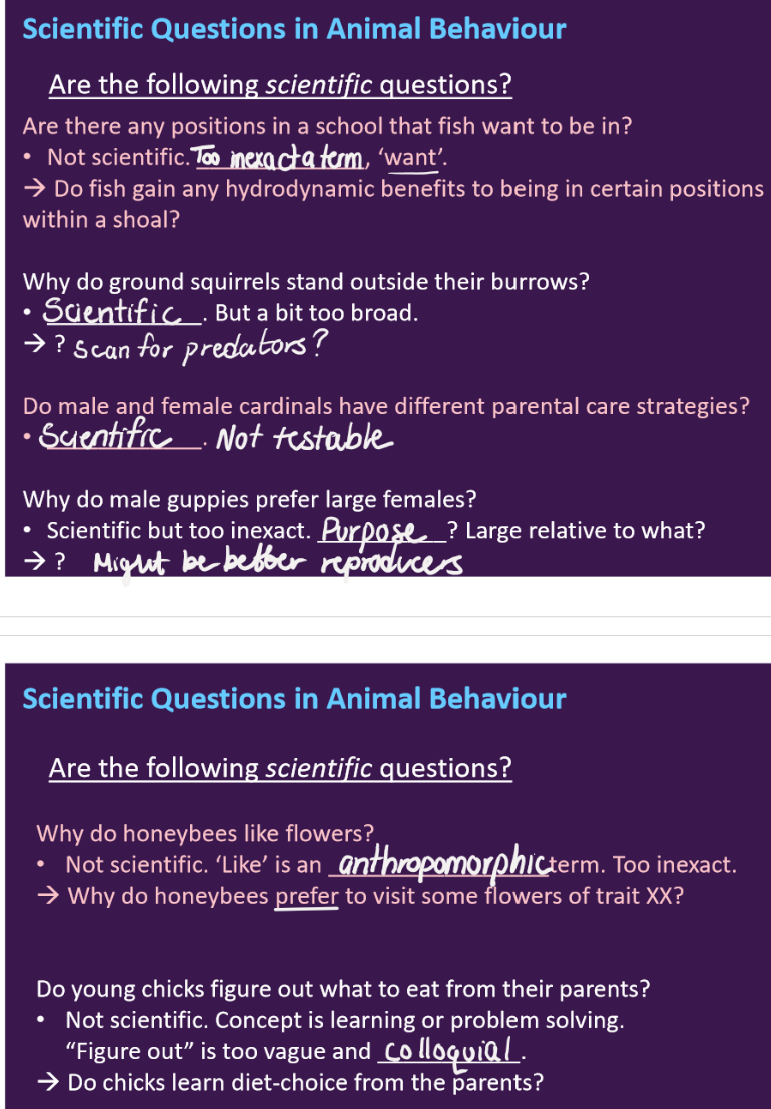
Studying animal behaviour - state hypotheses and make predictions
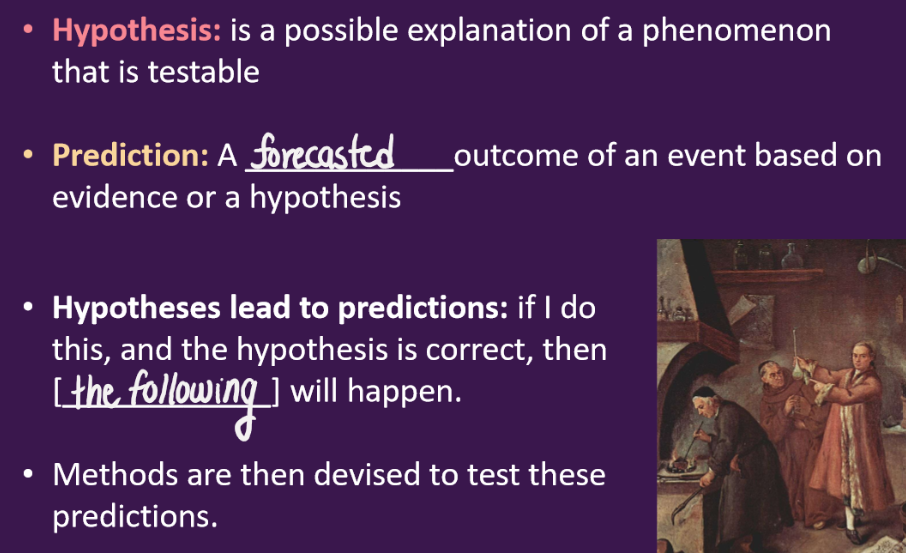
Testable hypotheses, predictions and methods example
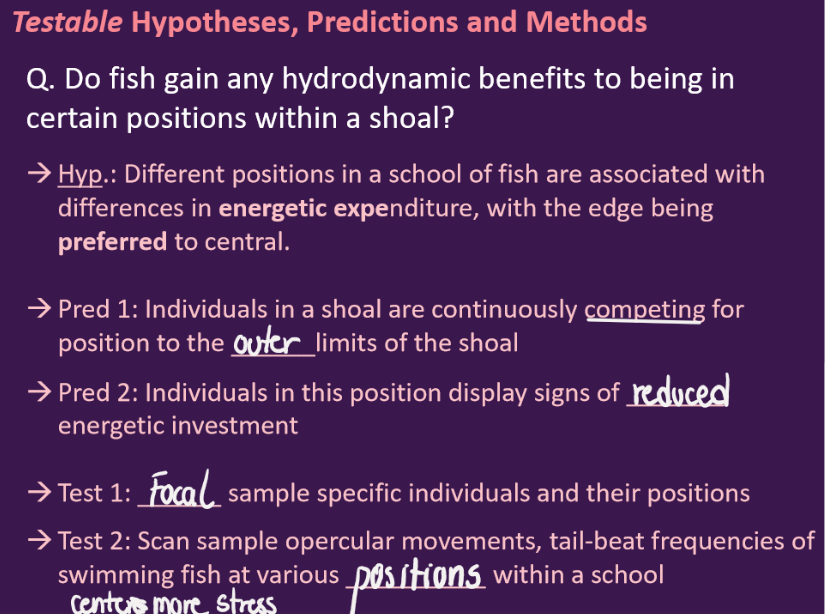
Testable hypotheses, predictions and methods example
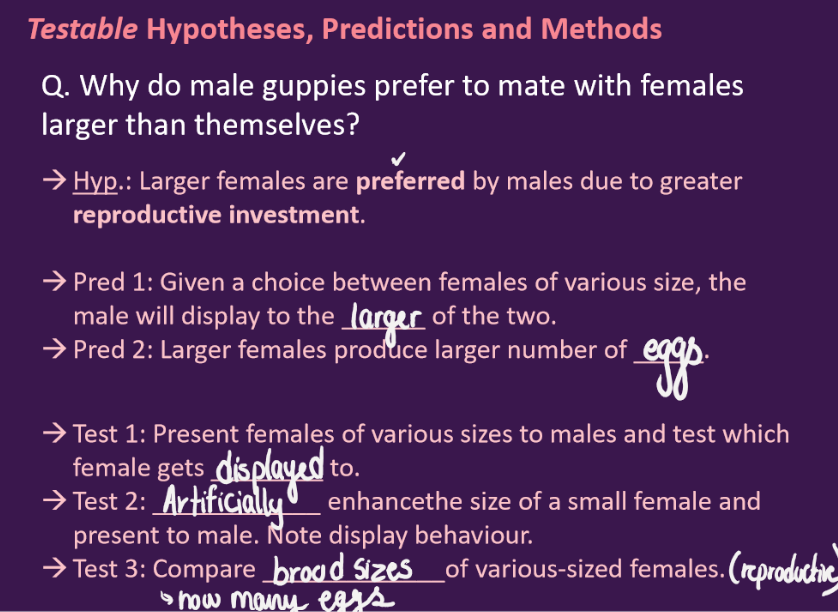
Testable hypotheses, predictions and methods example
Observation - Eastern grey squirrelsoften flag their tails while clinging to trunk of the tree
Question - post tinburgens 4 questions - why do squirrels flag their tails (not yes or no, is broad but if hypothesis is good dw)
Hypothesis - proposed explanation made in basis of limited evidence - tail flagging in eastern grey squirrels is an antipredator warning signal (intent, not que)
Prediction - if tail flagging is a warning signal, then it should occur when other squirrels and a potential threat are present
Test- Design and conduct experiment/observational study - Measure if trail flagging is more present when conspecifics (many squirrels) are present versus absent with a predator cue (many squirrels but cue of predator seen) and then see if no squirrels around and still does it.
Testing hypotheses of the adaptive basis of behaviour
3 empirical approaches (ways to test predictions)
Observational
Most basic, observed in natural habitat to understand adaptive basis of behaviour (direst/indirect)
Ethograms (time spent doing something)
Focal follows (follow fish in school)
Scan sampling ( Dan Mennill lab data - students - little bias)
Telemetry - collars, GPS trackers
Tissue analysis - blood samples
Gene expression
Observational studies produce emprical data (numbers) that can be used to generate. support and refute hypotheses - determine circumstances in which a behaviour is expressed
Example - saw rooster call out when predator is in sky, hypothesis = rooster calls to warn with mating females - test this - m in cage no f and fly shadow of hawk and see what male does - still calls - refute - maybe to altert the predator that its been detected - f audience not required for rooster to call
Determine how variation in the expression of a behaviour relates to differences in an individuals circumstances
Example - time spent vigilant in a flock is not absolute but depends on proximity to a group (center more protected for pigeons)
Problems with observation approach
Based on correlations - does not imply causation- Experimental manipulations does but not everything can be manipulated
Another variable may underlie the behaviour - "males with large antlers have greater reproductive success” this doest not mean that antler size directly controls reproductive success - antler size may be a correlate of other factors that determine reproductive success - actually, antler size is also correlated with age and body size (experience) - when age and size held constant antler size has no effect on malereproductive success - how to measure - take all elk of same size and stick different antler sizes - doesn’t not attacks more females - has to do with body size and age
Comparative
Conduct comparison of groups (species, sub species, populations) to determine how differences in behaviour reflect their difference sin ecology. Members of the same species or closely related species are tuded in different environmental conditions. Different environments impose different selection pressures. Differences in behaviour can be attributed to natural selection adapting animals to their habitat. Useful to examine broad trends in evolution, social organization, ecology and cognitive ethology.
Example - social behaviour of marmots - what is the adaptive basis of coloniality in (Marmota) - difference s- 3 similar species -
Age of dispersal (when parents kick young out) 1. Woodchuck elevation low, kick out at 1 year old (intolerant and solitary), 2. Yellow bellied elevation medium, kick out at 2 years old (territorial and colonial agonistic), olympics elevation high, kick out at 3 (playful and colonial amicable)
What explains differences in sociality - elevation - herbivores, as you go up more harsh environment and shorter growing environment (not territorial at top bc don’t waste energy) more kin
Approach is also used with phylogenetics - how behaviour evolved, infer traits of ansectors - resolve phylogeny of species
Example - is color linked with swarming behaviour, have all swarming grasshoppers evolved from a gregarious ancestor
solitary don’t need much colour, but swarming locusts are red
Ancestor of red s sedentary grasshopper but it had colour plasticity to escape from predator if resources are low - was solitary - ancestors anscestor whs HIGHLY plastic (behavioural and color) - understood all of this bc of phylogenetic tree
Problems with comparative approach
Non-adaptive causes for difference s
Mutations, genetic drift and gene flow (non adaptive) - don’t reflect underlying ecology
Species are not always independent
For comparisons among species, need to control for independent evolutionary events (need closely related species and why they look different ) - species can share traits because they share common ancestor and therefore confound their independence - example looking at 6 species (good sample size) - but do phylogenetic analysis and ABC are closely related to DEF and now actually doing 2 comparison which is weaker statistically but that sok - this is called PSEUDOREPLICATION = A B C are all independent which is not true (inflating sample size illegally) - how to account for this - conduct phylogenetically independent contrast technique - grasshopper example - make tree based on gregariousness and colour and found 8 species (tips of tree) but take AVERAGE and plot
Experimental (manipulation)
Experimenter proposes hypothesis for adaptive function of a behaviour - usually based on previous observation and/or correlation
Manipulates some aspect of the animal/environment to test hypothesis OR uses analytical models and or simulation models that represents the system or hypothesis to answer the questions
Manipulating some aspect of the animal example
Adaptive head colors in finches 3 head colors in 1 species species. Polymorphism. Red and black gang up and beat yellow heads . And red also dominates black. Manipulated head colour (food coloring) - no effect on dominance! Unlike lizards, using something else not color! - maybe females choosing based on color
Another example
Patch residence and travel time in penguins - telemetry and foraging mode in penguins - go down feed on krill and do they forage optimally? How are they moving from one patch to another - not manipulative but determining experimentally. 3 modes 1. Diminishing return, increasing return, constant return . Diminishing return was most common method/theory = not waste time to stay in patch when quality decreases but close patch
Another example - virtual
Simulating predator prey - rules - nearest neighbor only and plugged into computer
Problems/Pros with manipulative experiments
Pro: Isolate variables
Con - difficult, time consuming, hard to observe behaviours, too artificial (label vs field)
Problems/Pros with Modelling approaches
Pros: make extrapolations of adaptivness of behaviours on other situations and can distinguish between competing predictions
Con- not real world har dto validate
Next lecture
